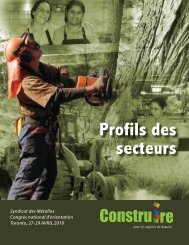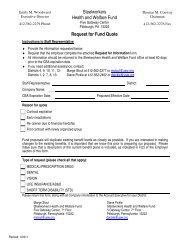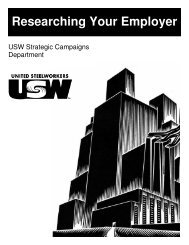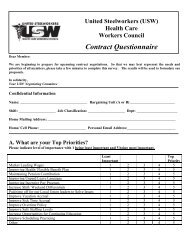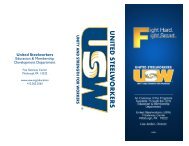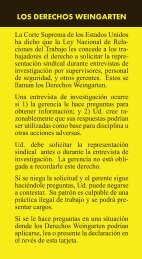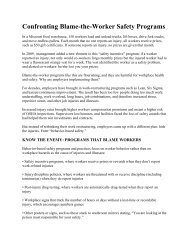Union Approach to Health and Safety: - United Steelworkers
Union Approach to Health and Safety: - United Steelworkers
Union Approach to Health and Safety: - United Steelworkers
Create successful ePaper yourself
Turn your PDF publications into a flip-book with our unique Google optimized e-Paper software.
914 DECISIONS OF THE NATIONAL LABOR RELATIONS BOARD<br />
members also ‘‘brought problems from the employees <strong>to</strong> the<br />
committee’’ (Tr. 1305).<br />
The evidence thus shows that although employee members<br />
of the seven committees are not elected by the employees,<br />
they serve in an agency relationship, representing the bargaining<br />
unit employees. In view of this finding I deem it is<br />
unnecessary <strong>to</strong> rule on the <strong>Union</strong>’s contention in its brief (at<br />
95–100) that because of the statu<strong>to</strong>ry language (‘‘any organization<br />
of any kind . . . in which employees participate’’),<br />
‘‘even if the committees here were not considered representational,<br />
they would still be labor organizations within the<br />
meaning <strong>and</strong> intent of the Act.’’<br />
I reject the Company’s contention that the committees<br />
function ‘‘only as a management vehicle.’’ I find that each<br />
of the seven safety <strong>and</strong> fitness committees is a ‘‘employee<br />
representation committee’’ <strong>and</strong> that although the employee<br />
committee members are not elected, an agency relationship<br />
exists between them <strong>and</strong> the bargaining unit employees they<br />
represent.<br />
(2) Dealing with employer<br />
(a) In general<br />
The statu<strong>to</strong>ry definition of a labor organization (quoted in<br />
full above) requires that the organization exists at least in<br />
part for the purpose of ‘‘dealing with’’ employers concerning<br />
‘‘conditions of work.’’<br />
There is no dispute that the purpose of each of the safety<br />
<strong>and</strong> fitness committees concerns working conditions <strong>and</strong> that<br />
both safety <strong>and</strong> fitness facilities, as well as benefits, are m<strong>and</strong>a<strong>to</strong>ry<br />
subjects of bargaining. ‘‘Employee health <strong>and</strong> safety<br />
indisputably are m<strong>and</strong>a<strong>to</strong>ry subjects of bargaining.’’ Oil<br />
Workers Local 6–418 (Minnesota Mining) v. NLRB, 711 F.2d<br />
348, 360 (D.C. Cir. 1983).<br />
Contrary <strong>to</strong> the Company’s contention in its brief (at 134–<br />
155) that none of the seven committees ‘‘deal with’’ it within<br />
the meaning of Section 2(5) of the Act, I agree with the<br />
General Counsel (in his brief at 91–92) <strong>and</strong> the <strong>Union</strong> (in<br />
its brief at 91–93) that bargaining unit employees on the<br />
committees deal with the Company at different levels.<br />
First, at the committee level, the employee members act on<br />
behalf of other bargaining unit employees in dealing with the<br />
management members, who represent the Company. Second,<br />
when approval of higher management is required for proposals<br />
on which both employee <strong>and</strong> management members<br />
agree at the committee level, or when action is required by<br />
other management, the committee through one or more of its<br />
members deals with the Company at the other level.<br />
The dealing consists of various forms. One is when bargaining<br />
unit employees take their safety complaints or requests<br />
for fitness facilities <strong>to</strong> the committee or its employee<br />
members—rather than through stewards <strong>to</strong> the <strong>Union</strong>—as a<br />
faster or more effective way of getting results. The employee<br />
<strong>and</strong> management members discuss the matters in the meetings<br />
<strong>and</strong> try <strong>to</strong> resolve them. One of the stated ‘‘key functions’’<br />
of the Freon Central <strong>Safety</strong> Committee, for example,<br />
is <strong>to</strong> ‘‘Become a forum for discussion <strong>and</strong> resolution [emphasis<br />
added] of safety concerns’’ (G.C. Exh. 11 at 33).<br />
Another form of this dealing is the employee members acting<br />
on behalf of bargaining unit employees in seeking larger<br />
or more appropriate safety awards. Previously, as found,<br />
when employees complained <strong>to</strong> the <strong>Union</strong> that management’s<br />
safety prizes were becoming insignificant in value or were<br />
being reduced in value (before the Company created the<br />
PEP-style safety committees), the <strong>Union</strong> would bargain with<br />
the Company in executive meetings for ‘‘a greater prize for<br />
[the employees’] accomplishments.’’<br />
Another form is the employee members’ acting on behalf<br />
of bargaining unit employees—instead of the <strong>Union</strong>’s acting<br />
on their behalf—in seeking <strong>to</strong> improve the effectiveness of<br />
safety audits by assigning employees <strong>to</strong> serve with members<br />
of management in conducting nonpunitive safety audits. Still<br />
another form is discussing <strong>and</strong> proposing changes in the<br />
<strong>Safety</strong> How manual, which directly affects the employees’<br />
working conditions.<br />
The complaint alleges that the Company unlawfully bypassed<br />
the <strong>Union</strong> in dealings with the committees: since the<br />
beginning of the limitation periods for the safety committees<br />
<strong>and</strong> since the May 2–4, 1989 Design Team trial for the Fitness<br />
Committee.<br />
(b) By the seven committees<br />
(i) Antiknocks area safety committee<br />
This committee clearly substitutes for the <strong>Union</strong> in h<strong>and</strong>ling<br />
safety complaints for employees in the business unit<br />
since the September 22, 1989 beginning of the limitation period.<br />
Employees take their safety concerns <strong>to</strong> employee committee<br />
members by ‘‘word of mouth’’ or <strong>to</strong> the committee<br />
by dialing its ‘‘lead line’’ (dialing L E A D). They talk <strong>to</strong><br />
an employee member during the day or leave a message on<br />
the answering machine at night. Employee member James<br />
Graves <strong>and</strong> other committee members take turns listening <strong>to</strong><br />
the answering machine <strong>and</strong> ‘‘would get the problem <strong>and</strong><br />
write it down on a book <strong>and</strong> then it would be addressed at<br />
one of our meetings.’’ (Tr. 701–702, 742–743, 753–754.)<br />
Committee minutes for the February 13, 1990 meeting<br />
show an example. The minutes state that an employee member<br />
reported that ‘‘A need has been expressed for a central<br />
facility <strong>to</strong> put on <strong>and</strong> clean up, <strong>and</strong> remove acid suits. Object<br />
is <strong>to</strong> localize contamination.’’ (G.C. Exh. 7 at 74; Tr. 153–<br />
154).<br />
As another example, one of the committee’s ‘‘1990 Accomplishment’’<br />
reads (G.C. Exh. 7 at 125): ‘‘Welder’s clothing<br />
being punched at change house.’’ The evidence shows<br />
that someone had noticed that the flameproof suits were not<br />
being punched (<strong>to</strong> be replaced after being punched <strong>and</strong><br />
washed 25 times) <strong>and</strong> ‘‘brought it <strong>to</strong> the attention of the<br />
safety committee.’’ The committee contacted the change<br />
house attendant <strong>and</strong> arranged for the clothes <strong>to</strong> be properly<br />
punched <strong>and</strong> replaced. (Tr. 748–749; G.C. Exh. 7 at 74.)<br />
Other listed 1990 accomplishments included such safety<br />
matters as pot holes fixed, new covers put on ditches, person<br />
assigned <strong>to</strong> clean air hoses, sidewalk along seawall repaired,<br />
<strong>and</strong> exhaust pipe at shop repaired (G.C. Exh. 7 at 125).<br />
Committee members meet, discuss the problems, <strong>and</strong> try<br />
<strong>to</strong> resolve them. Often a designated committee member<br />
‘‘would find out who was in charge of that area <strong>and</strong> would<br />
present the problem’’ on the committee’s behalf. If the problem<br />
can not be resolved or takes <strong>to</strong>o long, the committee<br />
goes <strong>to</strong> the business unit manager. Then if the problem is not<br />
resolved, the committee may threaten <strong>to</strong> go <strong>to</strong> the plant man-




